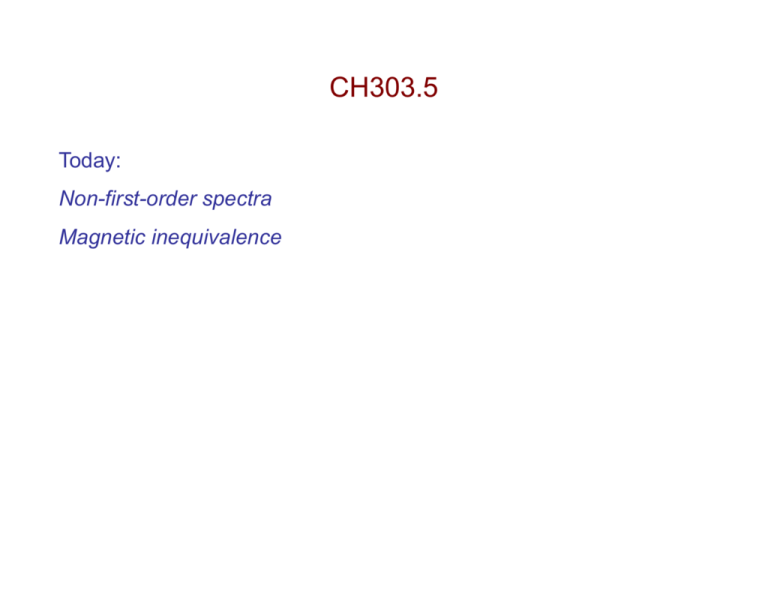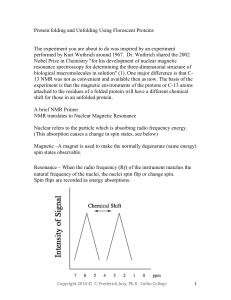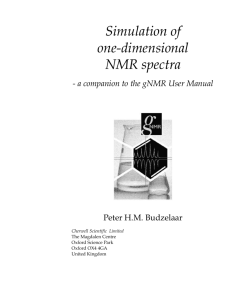CH303.5
advertisement

CH303.5 Today: Non-first-order spectra Magnetic inequivalence Non-first-order NMR spectra If δA - δB ≤ JAB, the NMR spectrum will not be first order (note the use of adjacent letters of the alphabet in this case). Non-first-order NMR spectra are typically complex and require computer simulation for the determination of the chemical shifts and coupling constants. Non-f irst order AB system Figure on the right illustrates how an AB system is going to appear in NMR spectra depending on δA - δB. As the difference becomes small, so the outer lines of the resonances of A and B become small. “Roof effect” A B -20 -10 0 10 20 Hz 2 Non-first-order AB2 spectra. Example: 1,2,2-trichloroethane The chemical shifts and coupling constants in a first-order AM2 spin system can be directly measured from the spectra. The non-first-order AB2 spectra are characterized by splittings that do not correspond to coupling constants, by distorted intensities, by chemical shifts that are not at the M2 A 5.77 3J AM = 6 Hz 3.99 200 MHz 5.82 5.34 4.86 4.38 3.90 4.31 3.75 60 MHz 6.00 5.44 4.87 B2 resonances’ midpoints, and by resonance multiplicities that do not follow the n+1 rule. A 20 MHz 6.50 5.75 5.00 4.25 3.50 3 Non-first-order ABC spectra. Example: Methylacrylate 5.84 H H 6.34 6.13 H 3.76 O O The following are examples of AMX (first-order) and ABC (non-first-order) spin systems. The ABC spectra have a complicated appearance. Such patterns often require computer simulation to determine the chemicals shifts and coupling constants. 4 Non-first-order ABX spectra. Example: A particularly subtle example of non-first order complexity occurs in an ABX spectrum when δA and δB are very close and JAX is zero. With no coupling to A, the X part should be a simple doublet from coupling to B (which is the case in an AMX system). Since A and B are closely coupled, the spin states of A and B are mixed, and the X resonance appears split by the B spins. This phenomenon has been termed virtual coupling. 5 Magnetic equivalence The nuclei are said to be chemically equivalent when they have the same environments. It is important to distinguish chemical equivalence from magnetic equivalence. Two nuclei are magnetically equivalent if they are identically coupled with other spins in the molecule. Here are examples of chemically AND magnetically equivalent protons: X J AX A A J AX A X X A 2 J AX 2 2 6 Magnetic inequivalence Here are examples of chemically equivalent AND magnetically inequivalent protons. Note that 3JAX ≠ 4JA’X in the first example and 3JAX(cis) ≠ 3JA’X(trans) in the second. Except when there are certain fortuitous combinations of the coupling constants, spectra of magnetically inequivalent nuclei can never be first-order! 7 Examples of magnetic inequivalence Example: 90 MHz 1H NMR spectrum of 1,1-difluoroethene in CDCl3. AA' part AA'XX' 4.4 4.0 3.6 3.2 ppm Example: 300 MHz 1H NMR spectrum of p-chloronitrobenzene in CDCl3. NO2 HA HA' HB HB' Cl 8 Examples of magnetic inequivalence Example: 300 MHz 1H NMR spectrum of o-dichlorobenzene in CDCl3. Cl HA Cl HB HA' HB' Example: 300 MHz 1H NMR spectrum of 2-phenyl-1,3-dioxolane in CDCl3. HB' H HA'B HA O H O Ph 9 Virtual coupling in non-first-order spectra An AA'M2M'2 spin system normally gives a non-first-order NMR spectrum. The appearance, however, depends on the coupling constants. The first spectrum on the right was calculated with 3JAA' = 100 Hz and looks deceptively simple. The M2M'2 part appears as a triplet (often called virtual triplet). The multiplicity may suggest an A2M4 system - which is not the case. M2M'2 5.20 3J 3 AM = JA'M' = 6.6 Hz 4J 4 AM' = JA'M = 0 Hz AA' 5.95 3J 6.25 5.91 100 Hz 5.57 3J 6.25 AA' = 5.91 5.24 4.90 5.24 4.90 AA' = 40 Hz 5.57 Only when 3JAA' is small the true complexity is revealed. 3J 6.25 5.91 AA' = 15 Hz 5.57 10 5.24 4.90









